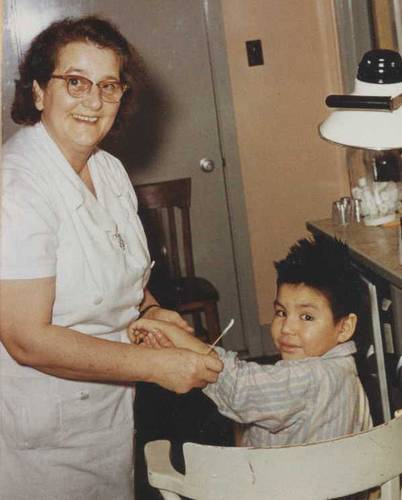By Marites N. Sison
Anglican Journal
Febriary 1, 2008
http://www.anglicanjournal.com/issues/2008/134/feb/02/article/school-nurses-diary/
"The children have lost their fear of the infirmary now and sometimes will come up to have the tiniest scratch attended to. It is amusing to see how some of the kiddies act when they do come. They will just point to the part that hurts and don't say a word – it is then up to me to find out how serious the hurt is."
So goes Sarah Elizabeth Page's diary entry on Sept. 15, 1956, her eighth day as the resident nurse at the Moose Fort Indian Residential School, in Moose Factory, Ont.
 |
| Sarah Elizabeth Page, who worked as a nurse at the Moose Fort Indian Residential School in Moose Factory, Ont., treats student Billy Diamond. Mr. Diamond became a successful businessman and native leader. He was the first Grand Chief of the Grand Council of the Crees, a political organization which he helped to form in Northern Quebec. He was a key figure in developing the James Bay and Northern Quebec Agreement for the Cree people. Photo from General Synod Archives |
The archives of the church's General Synod in Toronto recently received into its collection Ms. Page's diary, which offers a vivid account of the daily lives of staff and native children at the school. The institution was set up by the Ontario government and administered by the Anglican Church of Canada. Ms. Page's daughter, Betty, had earlier donated the collection to the diocese of Ottawa after her mother's death.
The diary, which also contains photographs and the names of more than 280 native children who attended the school from 1956 to 1957 is an important acquisition because it helps fill in the gaps of missing government records from that period, said General Synod archivist Nancy Hurn. "It provides a level of detail about the school that we almost know nothing about. The list of students has proven to be valuable in the verification process for the Common Experience Payment," she added. In May 2006, the federal government approved a $1.9-billion settlement package that provides a Common Experience Payment to all former students of Indian residential schools, as well as a process allowing those who suffered sexual or physical abuse to obtain compensation.
Ms. Page's diary is particularly poignant as she wrote in great detail about the children she ministered to, often noting how many craved her attention. "Was almost finished (with work) when little Sammy came up with a pain in his tummy – perhaps he just needed some attention," she wrote on Oct. 23, 1956. "I was very much surprised at the speed in which he recovered." She wrote about the "junior girls" who often sang to her in the examining room. "They sang so sweetly, it was very touching to hear the plaintive voices trying to keep in tune," she wrote. She also had several entries and a short story about the loneliness experienced by the only "Eskimo" boy in school, Charles. "Poor little fellow has had such a bad time in getting adjusted," she wrote.
The diary also mentioned high points in the school's life – the visit of Governor General Vincent Massey, the Halloween and Christmas parties for the children and staff – as well as the low points, including an epidemic of measles that hit the school in stages, affecting 100 children. "Seventy-five measles today. I am running around like mad," she wrote on Oct. 8, 1956. "The high temperatures are giving the children nosebleeds galore."
Any original material on these pages is copyright © BishopAccountability.org 2004. Reproduce freely with attribution.